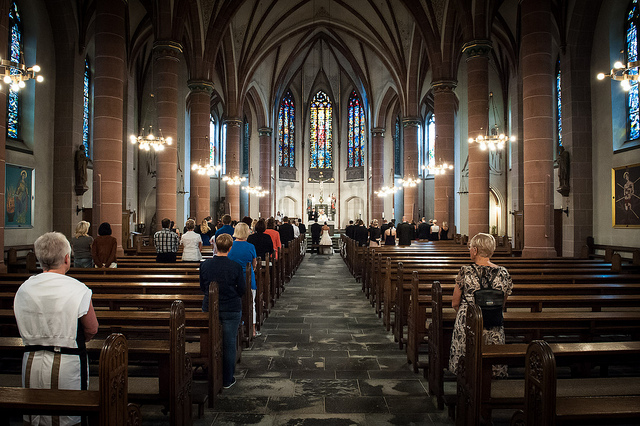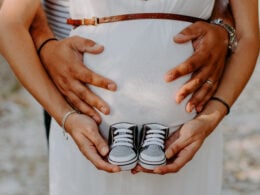I am a Frenchman in San Antonio, TX. Not many of us live here. So when I hear about one who sounds like a possible friend, I make an effort to meet him. Even if it’s at his wedding.
My curiosity paid off with rich ideas and inspirations: about love, marriage and even fertility awareness, and this post is my Valentine’s Day tribute.
A priest friend of mine, Father Charlie Banks, had told me about Antoine a few months before. A Frenchman getting married in a Catholic Church in Texas: he was an extreme rarity. Father Charlie was the one helping him and his fiancée prepare for the ceremony, as they made occasional trips here from Houston.
I almost didn’t make it to the wedding. That morning I had about hundred other things on my mind and on my schedule and crashing the wedding Mass of a stranger was definitely not part of it. But when I saw Father Charlie at the 8 a.m. Mass that morning, he kindly reminded me again afterwards about it. I had to go.
Because I wasn’t part of the wedding party, it felt a bit strange at first. About 100 folks were there, all dressed in their finest, all pretty much kin to the bride or the groom. I was trying to spot the French side of the party, but it wasn’t that easy as they were obviously outnumbered by the American family and a bunch of Aggie friends.
You know what a wedding Mass is like. Or maybe you don’t, or maybe you‘ve forgotten. It starts with the family proceeding up the church’s main aisle, starting with the oldest generation. I loved to see the older folks I didn’t even know: grandparents, maybe even great-grandparents walking in, displaying for us the weathered gait of a full life, yet radiating the dignity of their age. It was striking how they reminded us of where we come from and where we’re going. They walked up the central aisle, taking the same path as the priest who symbolically brings God into the midst of the people gathered there as a ferment for our souls. I thought that in their own way, they too were powerful image bearers as they walked in for this special occasion, and they too gave us a vision for a life well lived and a purpose fulfilled.
Then the groom kindly walked in the bride’s mother, took his place and looked expectantly toward the end of the aisle. Antoine is a tall, dark-haired young man. His expressive eyebrows and broad smile underscore a warm, caring and gracious demeanor. He seemed well at ease and confident for someone who’s only been in the US for two years. He waited patiently.
Then the music changed to a more majestic tune. The father brought in Amanda. As a father of a 22-year-old young lady, I couldn’t help but feel deeply this moment. I know what it means to love someone unconditionally with the duty of a provider, encourager and benevolent leader. I know how a daughter relies on this love to become who she is as an adult. If you water them carefully with affirmation and wisdom, they bloom like a rosebush. I also know that she’s not mine and that one day, I will hand on the responsibility of “first man” in her life to another. It will be difficult, but a hopeful symbolic gesture. I still choke up every time I see another man make that step.
When the father and daughter reached Antoine, something very special happened. Antoine looked his new father-in-law in the eye, shook his hand and graciously thanked him even before he looked at Amanda. The father then turned to his daughter and she kissed him goodbye on the cheek, and Antoine took her arm to bring her to the altar. You could tell this was an important 30 seconds for these folks: something they would never forget and that created a new bond between all of them. There was something so legitimate and honorable about the way it was done. It was like bread done right, it will rise.
The Mass took its course, with the young couple sometimes sitting, sometimes kneeling in front of the altar. Father Charlie spoke of covenant, of giving one another’s flesh and blood, just as Jesus Christ gives us his flesh and blood, and how through this act of love, He was joining himself to the relationship between Antoine and Amanda. He spoke about the good times and the hard times ahead.
We were also reminded that the wedding is different from any other sacrament in the way that the celebrant, or officers, of this event are not the priest, but the groom and his bride. They’re the ones that make everything happen, and the liturgy, the words they say, which have roots as far back as ancient Jewish rituals, beautifully invoke the meaning of their commitment.
Antoine and Amanda shared their vows. Antoine had learned his part by heart and had enough composure to remember them without the priest’s help.
“I, Antoine, take you, Amanda to be my wife. I promise to be true to you in good times and in bad, in sickness and in health. I will love you and honor you all the days of my life.”
“I, Amanda, take you, Antoine, to be my husband. I promise to be true to you in good times and in bad, in sickness and in health. I will love you and honor you all the days of my life.”
The Mass went on with high points such as the nuptial blessing, which takes us back to the meaning of creation of a man and a woman and why they’re made for one another.
You know what the most interesting thing was that happened to me while I sat there? I felt more in love with my wife, more purposeful about our 25 years of marriage, more joyful thinking about the legacy we were leaving with our children. I thought: this marriage-crashing stuff is a real marriage booster! Then I realized something profound: years ago, my grandparents probably attended a wedding like this two or three times a year. There was always a brother, a cousin, a neighbor, or one of their own children or grandchildren getting married in the tiny French village where they lived. So they got the inspiring reminder often, much more often than we do now. No wonder they stayed together over 65 years, until death parted them.
I also reflected on the meaning of the nuptial love, which is so much more than a physical experience. What if they were using contraceptives? Would that change anything? Would that take away from the vows they made? The idea of one flesh expressed in the nuptial vows is a pretty powerful concept. It reminded me of that idea that my wife is like my own body: if she suffers, I suffer. If she’s sick, I am sick. If she takes contraceptives that endanger her health, I’m also at risk.
I finally wondered about one question: what about the “honeymoon” and its potential for a pregnancy? They say that before electric lighting, women’s cycles followed the waxing and waning of the moon, with ovulation and fertility at the time of the full moon. Could that be where “honeymoon,” a term so curiously present in many languages, comes from? The “sweet” moon perhaps had to do with fertility when bearing children was an honor and being barren was considered a shame. In our day and age we’re much more disconnected from nature; couples feel less urgency to bring children into the world, and the honeymoon has a different meaning. Yet I can see how fertility charting can help newlywed couples reconnect with the fundamentals of nature and time, even if they choose to postpone pregnancy. A charting couple enjoys a more complete picture of emotional love, physical unity, and unity with nature itself.
It was a joy to meet this young couple at the end, even though it was the first time, I felt connected to them in a special way.
So do me a favor: go crash a wedding. It’s good for romance. Happy Valentine’s Day!











